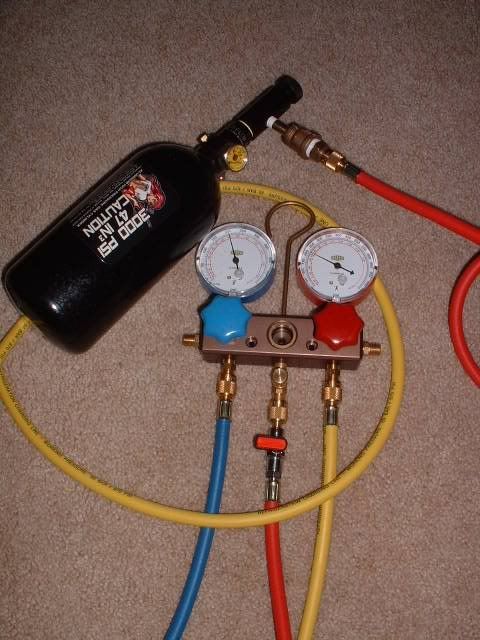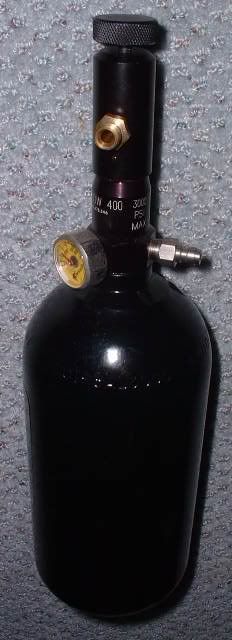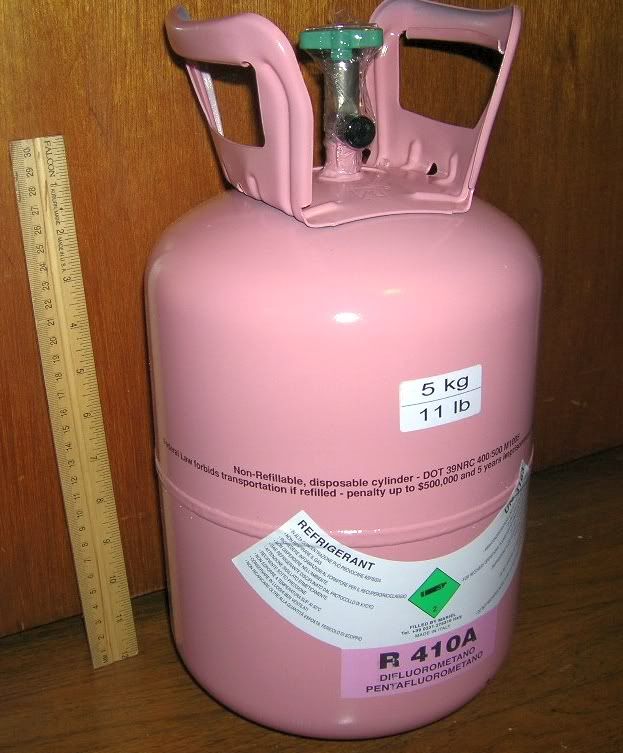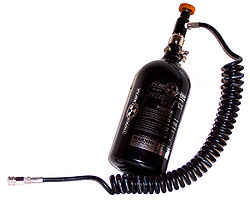
 |
|
|
#11 |
|
Lex Parsimoniae
Join Date: Feb 2009
Location: Woburn, MA
Posts: 4,918
Thanks: 114
Thanked 250 Times in 230 Posts
|
Hi Tom,
If you absoluly can't find nitrogen (at your local paintball shop etc), You could try air from a Scuba shop. It's very dry and pure. It's about 78 percent nitrogen & 21 percent oxygen. They keep it pretty dry, since any water in a scuba tank is a no-no. ~~~ Some installers don't do a real pressure test. They take a short-cut. They just give the system a quick shot of refrigerant and do the soap-bubble test on all the fittings. If opted to do this short-cut pressure test, it might be a good idea to hook up your vacuum pump and dry up the line set before letting any R410A into it. That will keep damp air from quickly mixing with refrigerant and making some ice.. This method is illegal in most countries, since you have to release the pressure, before running your vacuum pump. ~~~ After all the pressure testing & vacuuming is done and you are satisfied it's dry and tight, the last step is to release the refrigerant into the (evacuated) line-set. But, you start off the same way as above, with "a quick shot of refrigerant and do the soap-bubble test" etc. Before opening both valves fully.. If it's not in your manual, it's still good practice, IMHO..
__________________
My hobby is installing & trying to repair mini-splits EPA 608 Type 1 Technician Certification ~ 5 lbs or less.. Last edited by Xringer; 02-12-12 at 09:32 PM.. |
|
|

|
|
|
#12 | |
|
Lurking Renovator
Join Date: Feb 2012
Location: Triangle, NC
Posts: 8
Thanks: 4
Thanked 0 Times in 0 Posts
|
Quote:
How do they sell it? How much pressure is in the tank? What fittings are used? I was imagining having to go to some industrial supply places and getting one of those large industrial cylinders packed to some whopping pressure for my relatively meager needs... Tom |
|
|
|

|
|
|
#13 |
|
Apprentice EcoRenovator
Join Date: Dec 2010
Location: Western Australia
Posts: 148
Thanks: 1
Thanked 48 Times in 34 Posts
|
Paintball shops here usually sell CO2. Provided the CO2 is dry there is absolutely nothing stopping you using that instead of N2.
I use a D sized N2 tank. It holds about 1.2cuM (1200L) of gas at an initial pressure of just over 2500PSI. You *need* a regulator with one of these. Too many people have died trying to get away without one. You could probably use a paintball tank and a needle valve. Heck, even a Soda-Stream bottle might do what you need. They seem to hold a hundred litres or so of Gas. The idea of Scuba air is a good one. They use dessicant driers to make sure the air is *really* dry, but again 2500PSI is a lot to be playing with. |
|
|

|
|
|
#14 |
|
Lurking Renovator
Join Date: Jan 2012
Location: Artic Circle
Posts: 27
Thanks: 2
Thanked 8 Times in 6 Posts
|
Exxellent comments in every respect from all of you.
Behind this all is the battle against .... oxygen! H2O is a biproduct coming along with Air and in excessive amounts to be abolished at any reasonable means from the system due lack of dryers (mini-splits)! The bad thing happens if the refrigent will be overheated in the discharge line... due to reasons still beyond comparison to my mind. Once the system is commissioned the refrigerant (r410a) will draw all available moisture from POE-oil and Cu- pipelines and settle down in equilibrium between all phases in the system. The question is: How much the system will tolerate Air/H2O ,when the goal is a long-term drive (say 15years)? My point in this thread was to arise debate on the "reasonable practices" prevailing in HVAC business in terms of BATTLE of TRACES in the system. Sometimes I feel there is huge lack of sense of proportions at the war against oxigen-based ingredients in mini-splits. I try to find out how a DIY-man could... avoid doing things right ... instead of doing right things. If dryers exist in HFC (like r410a) systems ,moisture is practically of no concern.The dryer are well capable to cope with that. In HCFC -systems (like r22) the clorine and Air (and H2O as a source of oxygen) is a real mess to be avoided! QUOTE from before: Original H2O in system in "standard state" ====================================== R410a 1000g => 10 mg H2O (max. allowed H2O 10 ppm) POE-oil 300g => 15 mg H2O (... " ..... " ......... 50 ppm) ======================================= Purging alternatives ... pipeline 2x7,5m=>volume 0,5 litres Propane (R290) 0,5 litres => 1/100 mg H2O (max. allowed H2O 10 ppm) Propane (95%) 0,5 litres => 0,2 mg H2O (max. allowed H2O 200 ppm) -------------------------------- AIR 0,5 litres => 7,5 mg H2O (+15degC, 15g moisture in 1m3 of air) |
|
|

|
|
|
#15 | |
|
Lurking Renovator
Join Date: Feb 2012
Location: Triangle, NC
Posts: 8
Thanks: 4
Thanked 0 Times in 0 Posts
|
Quote:
Even if I use compressed atmospheric air (not specially dried) to pressure test the lines, since there is so little volume in the linesets, I won't be introducing a total amount of H2O that is outside of specification? Further, if I then vacuum the lines to 500 microns (or, at least, below the vapor pressure of water), then the bulk of even that limited amount of water will be removed from the linesets? Tom |
|
|
|

|
|
|
#16 | |
|
Lex Parsimoniae
Join Date: Feb 2009
Location: Woburn, MA
Posts: 4,918
Thanks: 114
Thanked 250 Times in 230 Posts
|
Quote:
Since this is line-set only, you will not be contaminating filters etc inside the ODU. But, I would not use air right from your garage air compressor, it's loaded with water. And, do not try to use C02. It's very reactive when heated. If you added a little too much, your lineset could be exposed to unsafe pressures. (900+ PSI). Nitrogen from your local Paintball shop will be at 3,000 PSI.. And a small tank will run low on pressure pretty quick. I once had to go back for a refill in the middle of testing. I had a hacked connection to get 1/4" SAE at first,  But got a spare manifold fitting to use on my PB valve. You can find a PB extension rig on-line or at a PB shop for about $20.  If you don't want to buy all that stuff, they sell R410A on Ebay. You could use that for a test gas real easy..  Smaller cans too..  It is important to get all the moisture out of the line set, so you are likely to need some vac extra pump oil to get that job done.
__________________
My hobby is installing & trying to repair mini-splits EPA 608 Type 1 Technician Certification ~ 5 lbs or less.. |
|
|
|

|
| The Following User Says Thank You to Xringer For This Useful Post: | TomWS (02-13-12) |
|
|
#17 |
|
Lex Parsimoniae
Join Date: Feb 2009
Location: Woburn, MA
Posts: 4,918
Thanks: 114
Thanked 250 Times in 230 Posts
|
 (Take out the hose and install a standard 1/4" SAE fare fitting). I just looked on-line and these are getting harder to find.. This is stuff I had on hand for air rifles, so I used it. CO2 tanks attach also and can be used for brazing copper (instead of nitrogen). Here's a link to some of my first install.. http://ecorenovator.org/forum/geothe....html#post4633 it might be useful.. Second install is here: http://ecorenovator.org/forum/geothe...ct-2011-a.html It got down to 12.9°F last night and my twin Sanyos never blinked.. 
__________________
My hobby is installing & trying to repair mini-splits EPA 608 Type 1 Technician Certification ~ 5 lbs or less.. |
|
|

|
|
|
#18 | |
|
Apprentice EcoRenovator
Join Date: Dec 2010
Location: Western Australia
Posts: 148
Thanks: 1
Thanked 48 Times in 34 Posts
|
Quote:
Now, in the olden days (read mostly before R410a but not always) pressure testing more than a couple of hundred PSI was a bad idea as the gas could leak past the service valves and contaminate the charge. "Mostly" these days it's not much of an issue. I have a second fan-coil in my ceiling at the moment that is unconnected. I have a "holding charge" of 400psi of N2 in it. I figure a month or two of 400PSI when I plan to use it on R290 (so maximums of less than 300) is a pretty good strength and leak test. Back to vacuum though.. If you vac to 500 Microns or less, and it holds there (and its not freezing out), then you _know_ you have no water and have removed enough of the non-condensibles not to worry about it. If you vac to 500 and it slowly rises to 1000 or more, then you have moisture that has turned to Ice and is slowly melting or subliming. Look at it this way. I have a fridgy mate who installs A/C units all day long. He follows the cheap Chinese instructions and terminates the lines, then purges them with refrigerant. His attitude is "the manufacturer recommends it". Is it any wonder than modern day splits last just long enough to endure the warranty period? Do it properly (with a _good_ vacuum) and you are multiplying your chances of things lasting longer than the warranty on the packet. I installed my own splits, and I just installed my own ducted heat pump. The money I saved on the installs more than covered the cost of an E-bay Vac pump, gauge set, N2 Reg and misc tools (many times over. I'm WAY ahead!). I _know_ it's done right. Having said that, the law does not smile on me like it does my mate who purges lines with refrigerants. I don't know what copper costs over there, but a roll of 3/8 | 5/8 lineset cost more than my vac pump + gauge set together. A bottle of N2 costs me $60 per fill and $15 per month. I can do a _lot_ of purging and testing for that, and when I run out for purging, a wise man taught me I can use propane to purge with. There's doing it yourself, and then there's doing it yourself the *right* way. |
|
|
|

|
| The Following User Says Thank You to BradC For This Useful Post: | TomWS (02-13-12) |
|
|
#19 |
|
Lex Parsimoniae
Join Date: Feb 2009
Location: Woburn, MA
Posts: 4,918
Thanks: 114
Thanked 250 Times in 230 Posts
|
"Now, in the olden days (read mostly before R410a but not always) pressure testing more than a couple of hundred PSI was a bad idea as the gas could leak past the service valves and contaminate the charge. "Mostly" these days it's not much of an issue."
It became an issue for me.. http://ecorenovator.org/forum/geothe...html#post16805 Maybe high pressure wouldn't have leaked into the charge, but I wanted to minimize that risk..
__________________
My hobby is installing & trying to repair mini-splits EPA 608 Type 1 Technician Certification ~ 5 lbs or less.. |
|
|

|
|
|
#20 | |||
|
Lurking Renovator
Join Date: Feb 2012
Location: Triangle, NC
Posts: 8
Thanks: 4
Thanked 0 Times in 0 Posts
|
Quote:
 Quote:
Quote:
 |
|||
|
|

|
 |
|
|